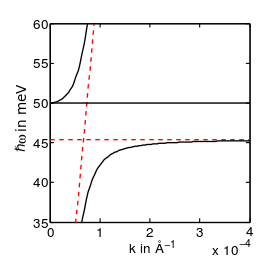Polariton

In physics, polaritons /pəˈlærᵻtɒnz, poʊ-/[1] are quasiparticles resulting from strong coupling of electromagnetic waves with an electric or magnetic dipole-carrying excitation. They are an expression of the common quantum phenomenon known as level repulsion, also known as the avoided crossing principle. Polaritons describe the crossing of the dispersion of light with any interacting resonance.
History
Oscillations in ionized gases were observed by Tonks and Langmuir in 1929. Coupled states of electromagnetic waves and phonons in ionic crystals and their dispersion relation, now known as phonon polaritons, were obtained by Tolpygo in 1950[2][3] and, independently, by Kun Huang in 1951.[4][5] Collective interactions were published by David Pines and David Bohm in 1952, and plasmons were described in silver by Fröhlich and Pelzer in 1955. Ritchie predicted surface plasmons in 1957, then Ritchie and Eldridge published experiments and predictions of emitted photons from irradiated metal foils in 1962. Andreas Otto first published on surface plasmon-polaritons in 1968.[6]
Types
A polariton is the result of the mixing of a photon with an excitation of a material. The following are types of polaritons:
- Phonon polaritons result from coupling of an infrared photon with an optic phonon;
- Exciton polaritons result from coupling of visible light with an exciton
- Intersubband polaritons result from coupling of an infrared or terahertz photon with an intersubband excitation.
- Surface plasmon polaritons result from coupling of surface plasmons with light (the wavelength depends on the substance and its geometry).
- Bragg polaritons ("Braggoritons") result from coupling of Bragg photon modes with bulk excitons.[7]
Principles
Whenever the polariton picture is valid, the model of photons propagating freely in crystals is insufficient. A major feature of polaritons is a strong dependency of the propagation speed of light through the crystal on the frequency. For exciton-polaritons, rich experimental results on various aspects have been gained in copper (I) oxide.
The polariton is a bosonic quasiparticle, and should not be confused with the polaron (a fermionic one), which is an electron plus an attached phonon cloud. Polaritons were first considered theoretically by Kirill Borisovich Tolpygo,[2][3] a Ukrainian physicist, and were initially termed light-excitons in Ukrainian and Russian scientific literature. The latter name was suggested by Pekar but the term polaritons proposed by Hopfield was adopted.
See also
References
- ↑ "Polariton". Oxford Dictionaries. Oxford University Press. Retrieved 2016-01-21.
- 1 2 Tolpygo, K.B. (1950). "Physical properties of a rock salt lattice made up of deformable ions". Zhurnal Eksperimentalnoi i Teoreticheskoi Fiziki (J. Exp. Theor. Phys.). 20 (6): 497–509, in Russian.
- 1 2 K.B. Tolpygo, "Physical properties of a rock salt lattice made up of deformable ions," Zh. Eks.Teor. Fiz. vol. 20, No. 6, pp. 497–509 (1950), English translation: Ukrainian Journal of Physics, vol. 53, special issue (2008); http://ujp.bitp.kiev.ua/files/journals/53/si/53SI21p.pdf
- ↑ Huang, Kun (1951). "Lattice vibrations and optical waves in ionic crystals". Nature. 167: 779–780. Bibcode:1951Natur.167..779H. doi:10.1038/167779b0.
- ↑ Huang, Kun (1951). "On the interaction between the radiation field and ionic crystals". Proceedings of the Royal Society of London. A. 208: 352–365.
- ↑ Otto, A. (1968). "Excitation of nonradiative surface plasma waves in silver by the method of frustrated total reflection". Z. Phys. 216: 398–410. Bibcode:1968ZPhy..216..398O. doi:10.1007/BF01391532.
- ↑ Eradat N., et al. (2002) Evidence for braggoriton excitations in opal photonic crystals infiltrated with highly polarizable dyes, Appl. Phys. Lett. 80: 3491.
Further reading
- Baker-Jarvis, J. (2012). "The Interaction of Radio-Frequency Fields With Dielectric Materials at Macroscopic to Mesoscopic Scales" (PDF). Journal of Research of the National Institute of Standards and Technology. National Institute of Science and Technology. 117: 1. doi:10.6028/jres.117.001.
- Fano, U. (1956). "Atomic Theory of Electromagnetic Interactions in Dense Materials". Physical Review. 103 (5): 1202–1218. Bibcode:1956PhRv..103.1202F. doi:10.1103/PhysRev.103.1202.
- Hopfield, J. J. (1958). "Theory of the Contribution of Excitons to the Complex Dielectric Constant of Crystals". Physical Review. 112 (5): 1555–1567. Bibcode:1958PhRv..112.1555H. doi:10.1103/PhysRev.112.1555.